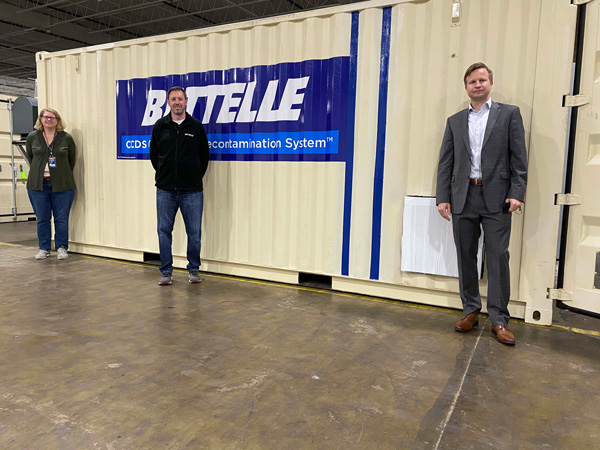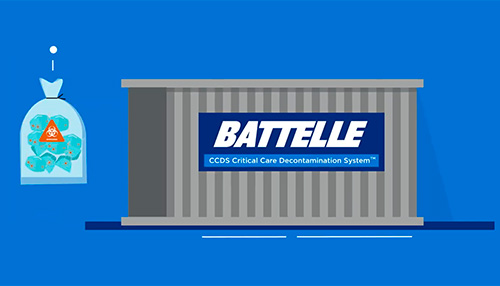Safe and sterile: Flyers at Battelle decontaminate PPE
When the COVID-19 pandemic hit the United States and began to spread rapidly in spring, many hospitals, first responders, health care workers and local governments were unprepared to adequately outfit workers with the proper personal protective equipment to keep them safe from contracting or spreading the virus.
Three University of Dayton graduates stepped up to meet the challenge of a U.S. solution to the PPE shortage. They have been part of an initiative that developed a system that decontaminates used PPE and certifies it for reuse.

Greg Kimmel ’01, Matt Zemanek ’04 and Carrie Cordonnier Sampson ’92 are employed by Battelle, the largest independent nonprofit research and development organization in the world. Based in Columbus, Ohio, Battelle has nearly 30,000 employees at more than 100 locations in the United States and around the world, including the national labs where it plays a management and operations role.
The organization specializes in applying cutting-edge technology to research, develop and manufacture solutions to issues in a variety of areas including health care, the environment, national security and materials science. About five years ago, Battelle worked with the FDA on a two-year study that led to the proof of concept for equipment that could clean and sterilize PPE for reuse if there was a shortage of equipment.
Battelle’s Critical Care Decontamination System uses concentrated, vapor-phase hydrogen peroxide to cleanse N95 masks. The need for masks was immediate, and there weren’t enough available in the United States to protect the frontline workers coming in contact with COVID-19 patients daily. The federal government asked Battelle to ramp up production of the CCDS and get them out to hot spots as quickly as possible.
“Once the project began, we had about a week to finalize design, develop and produce the initial unit,” said Zemanek, the production and engineering manager for the project. “The process was so quick that on the first day we started design finalization we were also working in parallel to procure materials, develop supply chains, establish manufacturing plans and identify locations to build,” he said.
The result was a partnership between government, nonprofit and private business sectors to deliver 60 CCDS units across the U.S. by mobilizing the necessary components to pull the plan together and getting equipment out in the field and operational in record time. Battelle diverted a substantial portion of its workforce to respond to the production of the CCDS units and meet the expedited delivery demand. Working 14-plus-hour days, seven days a week for nearly two months, the units have been deployed in hot spots around the country.
“It was completely understood that we are in dire times.”
“It was completely understood that we are in dire times, so being able to get the solution out to the field quickly, but also safely, in order to ensure that we are providing lifesaving support for the frontline health care workers and first responders has been a very rewarding opportunity for us,” Zemanek said.
Each CCDS consists of eight, 20-foot Conex boxes — like the kind seen on the back of tractor trailers — and has the capability to decontaminate up to 80,000 masks per day. Each mask is barcoded to count decontamination cycles and ensure they are returned to the owners through a meticulous chain of custody process. A single N95 mask can be treated up to 20 times, with the process taking about four to six hours to complete.
As the general manager of the CCDS program, Kimmel is responsible for all aspects of the production process including coordinating with government, state and local agencies as well as Battelle resources to get the equipment assembled, deployed, staffed and operational.
“Battelle is a very large organization,” he said, “and it’s been phenomenal how every support entity in the company has shifted its focus to respond to the pandemic. At the same time we are deploying the CCDS units, we are working in partnership with Ohio State University to develop COVID-19 tests and vaccines.”
Zemanek and Kimmel both had co-op positions with Battelle while attending UD. With 20 and 22 years respectively with the organization, they found a synergy between the learn, lead and serve philosophy of the University and Battelle’s founder, Gordon Battelle, who said, “Original research is mankind’s most powerful weapon in solving the problems of nature.”
Sampson is a senior quality engineer working on the CCDS unit’s build-out.
“It feels great to contribute in such a tangible way to protect frontline workers.”
“It feels great to contribute in such a tangible way to protect frontline workers,” she said. “The sense of purpose and teamwork on this project is amazing and made the long hours and hard work worth it. I am very proud of what our team accomplished in such a short period of time. The commitment to service that UD exemplifies has stayed with me in my career, and working for a nonprofit like Battelle has helped fulfill my sense of purpose and service.”
 Kimmel agrees that the pandemic has turned the spotlight on the value of public and private collaboration, and in particular showcases the talent available in Ohio.
Kimmel agrees that the pandemic has turned the spotlight on the value of public and private collaboration, and in particular showcases the talent available in Ohio.
“This really highlighted how much talent Battelle has across the institution and what can really happen when you bring all that talent together to solve a singular problem,” he said.
Zemanek agreed.
“I think the CCDS program exemplifies what we define as excellence, collaboration and unity by our ability to rapidly deploy the science and technology solutions that are a direct benefit to healthcare workers and first responders,” Zemanek said. “It directly aligns with my educational experience at UD that integrated the learn, lead and serve philosophy in ways that brought us to this place today.”